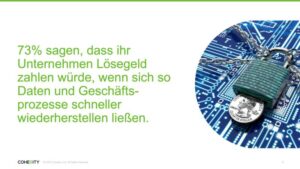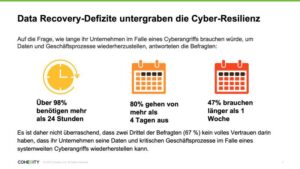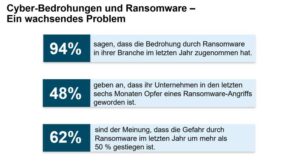
Cohesity study: When it comes to cyber resilience and recovery, 73 percent say their company would pay a ransom if it could recover data and business processes faster, especially when a full restore is needed.
94 percent of those surveyed in Germany confirm that the ransomware threat in their industry has increased in 2023: almost every second German company (48 percent) has been attacked in the last six months.
Almost every second company was attacked

🔎 Ransomware extortion: 73 percent would pay the ransom to get the business running again (Image: Cohesity).
Cohesity surveyed 3.400 decision-makers (500 of them from Germany) from the areas of IT and security operations (SecOps) on the subject of ransomware. The Global 2023 State of Data Security & Management Report study reveals glaring deficiencies in cyber resilience strategies and data security techniques. Both are essential to ward off growing cyber threats and maintain business continuity. If you do too little with data security and recovery, you can later claim less from your cyber insurance. This exacerbates the negative consequences of a successful attack.
94 percent of those surveyed in Germany* state that the threat of ransomware attacks for their industry has increased in 2023 compared to the previous year. Worrying: Almost half of respondents (48 percent) say their company has been the target of a ransomware attack in the past six months. 81% of respondents from Germany expressed concerns about whether their organization's cyber resilience strategy can address today's cyber challenges and threats.
73 percent would pay in an emergency
Maintaining business operations or at least being able to resume them quickly is crucial, especially in the case of cyber incidents. However, most companies fall short here because they are slow to recover data and business processes. When asked how long it would take their company to recover in the event of a cyber attack, almost all respondents (98 percent) answered that it would take them over 24 hours. Almost 80 percent of respondents in Germany say it would take more than three days, while almost half (48 percent) say it would take more than a week. Every fifth company (20 percent) even assumes that it will take more than 3 weeks.
Not surprisingly, over two-thirds of the IT professionals surveyed (71 percent) do not have complete confidence in their organization's ability to fully recover data and critical business processes in the event of a system-wide cyberattack. When it comes to cyber resilience and recovery, 73 percent say their company would pay a ransom if it could recover data and business processes more quickly, especially when a full restore is needed.
Lack of backup and disaster recovery

🔎 Almost half of respondents believe that data lost after an attack takes a week to recover (Image: Cohesity).
When asked about the top barriers to their business getting back up and running in the event of a successful cyberattack, respondents listed three reasons: outdated backup and recovery systems (34 percent), the lack of coordination between IT and security teams (32 percent), and that Lack of automated disaster recovery system (32 percent).
Less than half of respondents believe their data is safe and secure at the edge (46%) or in the cloud (39%). Less than three in ten (23 percent) respondents are confident that their locally stored data is secure.
Cooperation of the security solutions required
Accordingly, 80 percent of respondents agreed that it is important for data security and data management providers to work with cybersecurity solution providers to provide complete and integrated anti-ransomware solutions. More than eight in ten respondents (84 percent) believe their organization would benefit from a data security and data management platform that provides insights into overall security posture and cyber resilience.
Such data backup and recovery solutions are critical to qualifying for cyber insurance—but not all solutions are created equal. Although almost 3 in 4 (72 percent) of respondents confirm that their company has cyber insurance, more than half of all respondents (54 percent) say it is harder to get cyber insurance today than it was in 2020. For According to respondents, the top three technologies or skills required to purchase cyber insurance in the already highly competitive cybersecurity market are: the ability to verify the integrity of backups (36 percent), multi-factor authentication (35 percent), and strong Encryption (33 percent).
About the poll
Results are based on a global survey commissioned by Cohesity, Tenable, and BigID and conducted by Censuswide in late April 2023. More than 3.400 decision-makers were surveyed, half of whom work in IT and half in security operations (SecOps). Respondents came from companies in Australia, France, Germany (500), Japan, New Zealand, the UK and the United States. At the end of July, the overall results of Cohesity's Global 2023 State of Data Security & Management Report will be published, which will also include the results for Germany.
More at Cohesity.com
About Cohesity Cohesity greatly simplifies data management. The solution makes it easier to secure, manage and create value from data - across the data center, edge and cloud. We offer a full suite of services consolidated on a multi-cloud data platform: data backup and recovery, disaster recovery, file and object services, development / testing, and data compliance, security and analytics. This reduces the complexity and avoids the fragmentation of the mass data. Cohesity can be provided as a service, as a self-managed solution, and through Cohesity partners.

